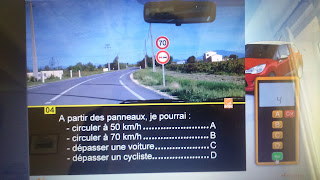Firstly, I would say that the
drivers in France are considerably better than in the States. They are taught
to drive preventatively, by which I mean they will gauge the traffic conditions
ahead and intuit a chain of events. I believe that, in the States, we all drive
in the instant, really only reacting to anything that effects a certain radius
around us. In the states, we pass in the right lane, and on freeways we stay in
the left lane and hit 70 mph bumper to bumper. All of those things are illegal
in France and they don’t do it. There is
almost no road rage, and cars with the right of way, get it. There is no
cutting in lanes at the last moment, and directionals are used 95 % of the
time. The odd exception, and I don’t know where it comes from is, the French
love to tailgate, it’s almost like they’re drafting Nascar style.
To
obtain a French Driver’s License in critical if you’re living over here. Sure, you can buy a car, have it pass the
Controle Technique (CT). The CT is essentially
an inspection of the vehicle. In the
states, you get a smog check, but here the car is put through a 75 point
inspection. The Make and model is entered into the computer, mileage and other pertinent
data is entered and the result is printed out. Using their data base, they zero
in on the most common instances of problems for that car. Aside from the basic
brakes, tires, electrical…e.i.e.i.o. they check the vehicle out thoroughly. The result is a vehicle that gets a clean
bill of health, it is also necessary prior to selling a car. It’s nice because any car you buy is almost
always problem free. Not like in the states where you could easily buy a lemon,
sure there are laws against selling a piece of garbage, but what a hassle if
you get stuck with one.
And aside from buying a car, you can
get that car insured. My understanding
though, is that if you are in an accident with an insured car, but not in possession
of a French Driver’s license, your coverage would be greatly reduced. This is true if you have lived here more than
six months, because after that time period it is required that you get a French
Driver’s License. The exception is if
you are part of the European Community. What with Brexit, there is a chance that when
England withdraws from the E.U., their retiree’s may need to get a French
Driver’s License.
“Alright; we get it…you need a
French Driver’s License. What’s the big fucking deal, Hank?”
“I’m going to tell you what the big
fucking deal is!” takes a breath, “it’s in French!”
“Alright, that’s not insurmountable,
big deal it’s in French.”
“And the wording of the questions is
the most counter intuitive sentence structure and even the basic logic is….dare
I say it….French.”
“That sounds a little xenophobic
Hank!”
“Fuck you, it took me five years to
get a FDR (French Driver’s License), although to be truthful, I was busy
renovating the house, taking care of the 50 acres, and learning to be a French
Vigneron.”
“Didn’t Caleigh and Cindy get theirs
pretty quickly?”
“They’re women, they’re better at
tests and studying and stuff. And Caleigh was fluent at that point.”
“You sound a little defensive there,
Hank.”
“Alright…maybe. Let me give you a couple
examples.”
“O.K., so this one is laughably
simple. I had only four examples I could find online. The correct answer is B.
Obviously, you are obligated to turn on the cars headlights when entering a
tunnel in the country. Not the position lights, or the high beams.”
“That was kinda simple, Hank.”
“Let’s try one a little more
difficult, shall we?”
“Go
ahead and study this one, although still a gimme on the test, it does require a
couple looks. If you were taking the test, what would your answer…or answers
be?”
Your answer / answers here.
“Firstly, you are on a two lane,
two-way road. As is evidenced by the dashed line on the left-hand side of the
furthest left lane. The dashed center lane permits passing or turning, however
the sign (panneaux) indicates that passing a car is not allowed. It is legal however to pass an industrial
tractor, or a scooter, cyclemotor, or a bicycle. So, we know instantly that:
Answer C is not allowed.
And, Answer D is allowed.
The circular sign above the no
passing a car indicated that 70 is the highest speed allowed.
Answer B is allowed.
So, so far we know Answer B and D
are correct. Now what about Answer A….50 k/h… maybe not because we know the
speed limit is 70 k/h.
And the answers are A, B, D. because
we all know that the word “pourrai” means “you could.” Not you “have to”. And
there is a calculation on the slowest speeds you are allowed to travel, and at
70 k/h, you can travel at 50 k/h without it being illegal. On the auto-route, as a for instance, 60 k/h is
the slowest allowed, provided you are in the extreme right lane. And because
every law has an exception or two, it is a law that in fog, heavy snow, or dense
rain, we all drive at 50 k/h. That way there aren’t massive pile-ups like one
hears about on the Grapevine in central California on a weekly basis. There are
so many hysterically insane questions that you will encounter on the French
Driver’s exam, the wording Byzantine, with logic that defies mere mortals grasps
on reality…but the end result are drivers that do understand that driving is a
right, that requires more than just a pedestrian thought process.
Bonne Route! (Happy Motoring)















